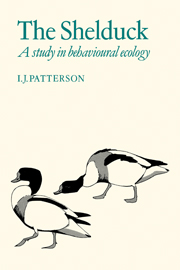Book contents
- Frontmatter
- Contents
- Acknowledgments
- 1 Introduction
- 2 The shelduck
- 3 Gregariousness: the winter flock
- 4 Territories
- 5 Prospecting for nest sites
- 6 Laying and incubation
- 7 Care of the young
- 8 Duckling survival
- 9 Recruitment and the non-territorial flock
- 10 The limitation of shelduck populations
- References
- Subject index
- Author index
4 - Territories
Published online by Cambridge University Press: 04 August 2010
- Frontmatter
- Contents
- Acknowledgments
- 1 Introduction
- 2 The shelduck
- 3 Gregariousness: the winter flock
- 4 Territories
- 5 Prospecting for nest sites
- 6 Laying and incubation
- 7 Care of the young
- 8 Duckling survival
- 9 Recruitment and the non-territorial flock
- 10 The limitation of shelduck populations
- References
- Subject index
- Author index
Summary
An animal can be said to show territorial behaviour when it has some attachment to a site (or occasionally to a moving object) and when it is aggressive towards other animals which approach that place. The resulting territory, around the site of attachment, has been defined in a variety of ways. Pitelka (1959) and Schoener (1968) emphasised the owner's exclusive use of an area, usually with defined boundaries, whereas Davies (1978) recognised territories wherever interactions between individual animals led to their being spaced apart more than would be expected from random settlement. Between these two extremes, I prefer the simple definition of territory as ‘a defended area’ (Noble, 1939; Nice, 1941). This embodies the essential features of a special place, around which there is aggressive defence, without implying particular features such as exclusive use or rigid boundaries, or particular consequences such as spacing out of the individuals, which may occur in many but not necessarily in all cases.
Territorial behaviour raises some interesting questions. Since aggressive defence of an area requires the expenditure of time and effort, there should be some corresponding benefit to the owner's fitness which outweighs the cost of territoriality (Davies, 1978). The spacing effect of territorial aggression would be expected to influence the dispersion pattern and density of populations. These possibilities are of particular interest in the shelduck since territorial defence, particularly by both members of the pair, is not common among ducks.
Shelduck territories
Towards the end of winter, from February to April, shelduck pairs detach themselves from the winter flock and scatter widely over muddy shores, or freshwater pools and creeks near the coast.
- Type
- Chapter
- Information
- The ShelduckA Study in Behavioural Ecology, pp. 78 - 106Publisher: Cambridge University PressPrint publication year: 1982

